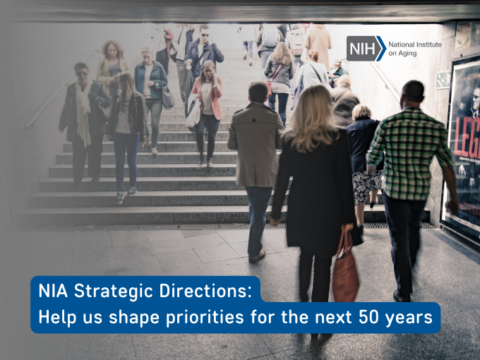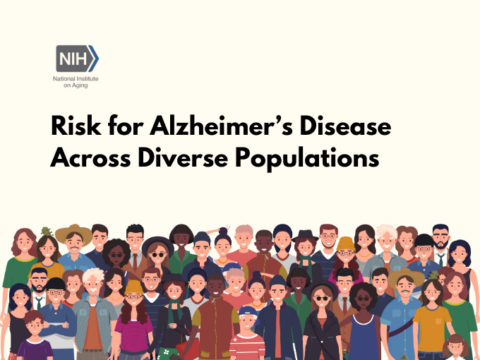
The National Institute on Aging (NIA), part of the National Institutes of Health, is developing the latest iteration of its strategic plan to guide the institute’s research priorities for 2026-2030. The first draft framework for the NIA Strategic Directions for Research, 2026-2030, presented below, was developed by integrating feedback from multiple sources, including a public request for information and input from staff across NIA’s extramural and intramural research programs. The draft framework consists of 10 broad goals, each of which is associated with 3-10 more specific objectives.
Through this form, NIA will accept feedback on the first draft framework for the NIA Strategic Directions for Research, 2026-2030. Any responses will be reviewed by NIA senior leaders and staff to assist in refining the framework and to inform development of a full draft of the NIA Strategic Directions for Research, 2026-2030.
Questions and general comments about the draft framework may be directed to niaplanning@nia.nih.gov. Additional information about NIA’s strategic planning process can be found at the NIA Strategic Directions for Research, 2026-2030 webpage (https://www.nia.nih.gov/about/provide-input-nias-strategic-directions-research-2026-2030).
Instructions: Below, you will see the goal(s) of the first draft framework for the NIA Strategic Directions for Research, 2026-2030. Review these and head to the NIAs online form to submit your feedback.
Responses must be received by 11:59 PM EST on January 31, 2025, for consideration.
Goal A: Better understand the biology of aging and its impact on the prevention, progression, and prognosis of disease and decline of function.
A-1: Identify genetic, molecular, and cellular factors that impact the rate of aging, and the development of age-related diseases and overall decline of function.
A-2: Determine how age-associated changes, from molecular and cellular to organ-based and organismal, contribute to decreased resilience and increased morbidity, and influence the response to treatment of age-associated conditions.
A-3: Identify factors associated with healthy aging and resilience against disease and dysfunction.
A-4: Advance the understanding of the heterogeneity of aging and its contribution to clinical outcomes and health disparities.
A-5: Understand the sensory and motor changes associated with aging in peripheral organs and how those changes lead to decreased function and increased risk of morbidity.
A-6: Identify and characterize interventions that hold the promise of increasing healthy lifespan.
A-7: Identify, develop, and validate objective and reproducible biomarkers that are applicable to aging and geroscience research.
A-8: Use comparative biology to understand aging processes in diverse species and apply that knowledge to advance translation of interventions that extend healthspan in humans.
A-9: Further the understanding of age-related alterations in immune system function, interorgan communication, and the microbiome and virome.
A-10: Develop and support experimental models and clinical trials to test the geroscience hypothesis.
Goal B: Better understand the effects of personal, interpersonal, environmental, and societal factors on aging, including the mechanisms through which these factors exert their effects.
B-1: Understand the basic behavioral, social, and psychological aspects of aging.
B-2: Illuminate the pathways by which social, psychological, economic, and behavioral factors affect health in middle-aged and older adults.
B-3: Identify developmental, prenatal, and early life exposures that affect individual differences in trajectories of biological, cognitive, and functional aging; the risk of disease and death; and the capacity for resilience and adaptation.
B-4: Identify and understand the environmental exposures, including the roles of extreme weather and natural disasters, that affect individual differences in biological, cognitive, and functional aging.
B-5: Explore the mechanisms that account for the effects of social adversity and disadvantage, including research that focuses on critical periods for reversing such effects and/or the optimal timing of intervention.
B-6: Better understand motivation, decision-making, and mechanisms of behavior change among older adults.
B-7: Consider the role of place in the aging processes, taking into account geography in studies of late-life disability and mortality trends.
Goal C: Develop effective interventions to maintain health, well-being, and function and prevent or reduce the burden of age-related diseases, disorders, and disabilities.
C-1: Develop efficacious and cost-effective strategies for promoting and ensuring adherence to healthy and safe behaviors among older adults.
C-2: Develop improved approaches for the early detection and diagnosis of disabling illnesses and age-related debilitating conditions.
C-3: Develop interventions for treating, preventing, or mitigating the impact of age-related diseases and conditions.
C-4: Find significantly improved and cost-effective ways to reduce caregiver, family, and patient stress and improve older adults’ ability to cope with chronic disease.
C-5: Develop strategies to improve the interaction of older adults with the health system.
C-6: Understand and develop strategies to enhance societal roles and interpersonal support for older adults, reduce social isolation, and promote positive caregiving outcomes and supports.
Goal D: Improve our understanding of the aging brain, Alzheimer’s disease, related dementias, and other neurodegenerative diseases. Develop interventions to address Alzheimer’s and other age-related neurological conditions.
D-1: Understand the mechanisms involved in normal brain aging; the role of plasticity and resilience in maintaining brain function; the role of cognition and sleep in everyday functioning; and protective factors for sensory, motor, emotional, cognitive, and sleep function.
D-2: Identify and understand the genetic, molecular, and cellular mechanisms underlying the pathogenesis of Alzheimer’s and related dementias (AD/ADRD) and other neurodegenerative disorders of aging.
D-3: Improve assessment and diagnostic tools for distinguishing people with normal brain aging from those who will develop mild cognitive impairment, Alzheimer’s disease, and related conditions.
D-4: Translate basic discovery into effective treatment and/or prevention strategies for AD/ADRD and other age-related neurological conditions.
D-5: Better understand and develop interventions to address the special caregiving needs of patients with AD/ADRD, as well as the needs of their caregivers.
D-6: Track epidemiologic trends in AD/ADRD, including incorporating new measures into national surveys.
Goal E: Improve our understanding of the consequences of an aging society to inform intervention development and policy decisions.
E-1: Understand how population aging and changes in the social, economic, and demographic characteristics of cohorts reaching old age affect the health and well-being of older adults in the U.S. and other countries.
E-2: Understand how social and economic factors throughout the lifespan affect health and well-being at older ages.
E-3: Understand how extreme weather and other natural disasters affect health and mortality at the population level.
E-4: Conduct research aimed at modifying organizational or individual behaviors in order to improve important health outcomes among members of population groups at older ages.
E-5: Understand and address the reasons the U.S. is falling behind other countries in health and mortality.
Goal F: Understand health disparities related to aging and develop strategies to improve the health status of older adults in diverse populations.
F-1: Identify and understand environmental, social, cultural, behavioral, and biological factors that create and sustain health disparities among older adults.
F-2: Develop strategies to promote active life expectancy and improve the health status of older adults in diverse populations.
F-3: Develop and implement strategies to increase and monitor inclusion of underrepresented populations in aging research.
F-4: Support research on women’s health, including studies of how sex and gender influence aging processes and outcomes.
Goal G: Support the infrastructure and resources needed to promote high-quality research.
G-1: Foster interdisciplinary research and knowledge exchange and encourage new collaborations across disciplines.
G-2: Engage in partnerships within and among institutions and organizations, including patient and advocacy groups.
G-3: Provide support for effective data management and sharing across research communities.
G-4: Train and attract the workforce necessary for rigorous research on aging, including new, midcareer, and senior investigators.
G-5: Attract and train more researchers from diverse scientific and cultural backgrounds.
G-6: Develop, maintain, and share research resources.
G-7: Develop the necessary infrastructure to encourage translation of research between basic discovery and intervention development.
Goal H: Support the development and application of new tools and technologies to study aging, including imaging, engineering, modeling, and AI- and machine learning-based approaches, and encourage secondary analyses of existing datasets.
H-1: Develop and leverage artificial intelligence and machine learning to increase research capacity.
H-2: Develop, maintain, and utilize large datasets, including the establishment of common data elements.
H-3: Develop tools to facilitate seamless, secure, and straightforward collection of biological, cognitive, and functional data from older adults in real-world settings.
H-4: Develop and deploy procedures to ensure data security and privacy.
H-5: Establish robust and secure data-sharing policies.
Goal I: Reach and engage multiple audiences with evidence-based information about aging, aging research, and science advances.
I-1: Increase awareness and promote adoption of evidence-based strategies to improve the health and quality of life of older adults.
I-2: Disseminate information to the public, broader scientific community, health care professionals, journalists, policymakers, and not-for-profit organizations about NIA-funded and conducted research and scientific advances.
I-3: Research, implement, and evaluate NIA communications strategies and materials to best understand and meet audience needs and ensure the continuance of high-quality information.
Goal J: Effectively steward public resources.
J-1: Optimally manage research funds through careful planning and priority-setting, scientific review, and evaluation of investments.
J-2: Encourage innovation across all areas of our mission.
J-3: Ensure transparency across the research enterprise.
J-4: Recruit and retain a highly qualified and diverse workforce.
J-5: Identify and effectively manage risks that may affect the research enterprise.
J-6: Provide administrative solutions to support research operations.
J-7: Deploy emerging technology effectively and ethically to augment mission support.

 Print This Post
Print This Post





